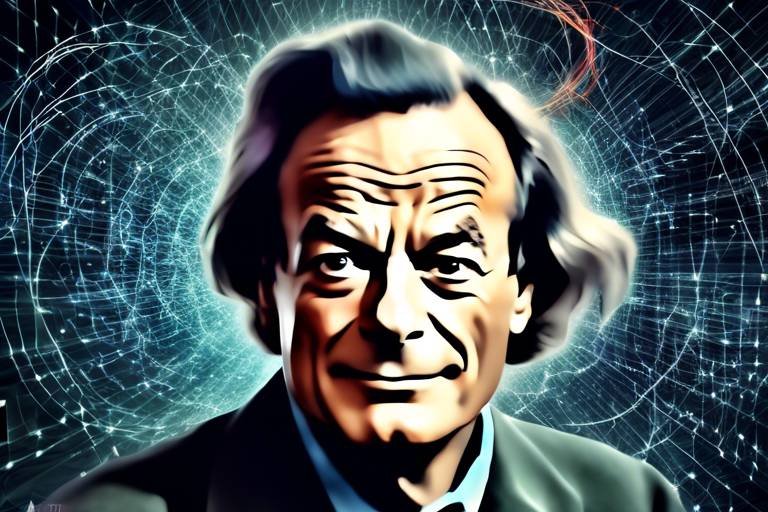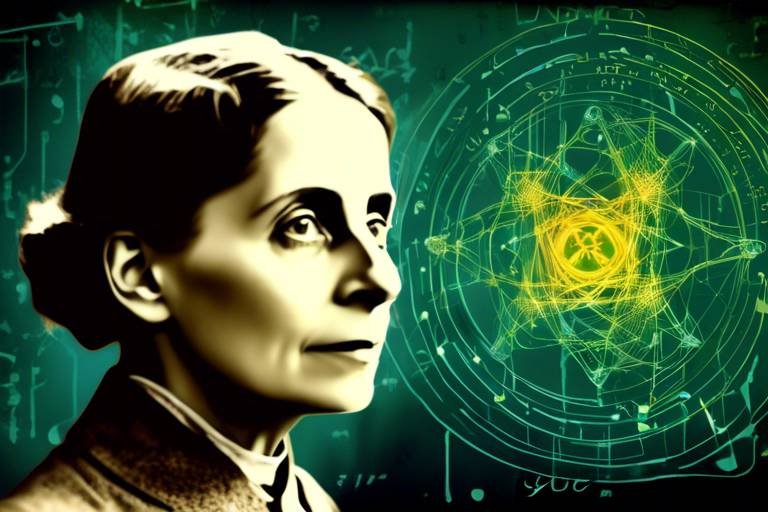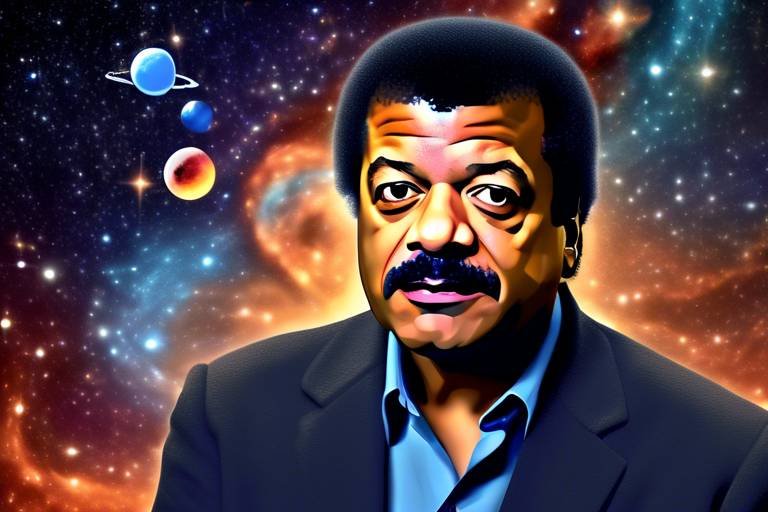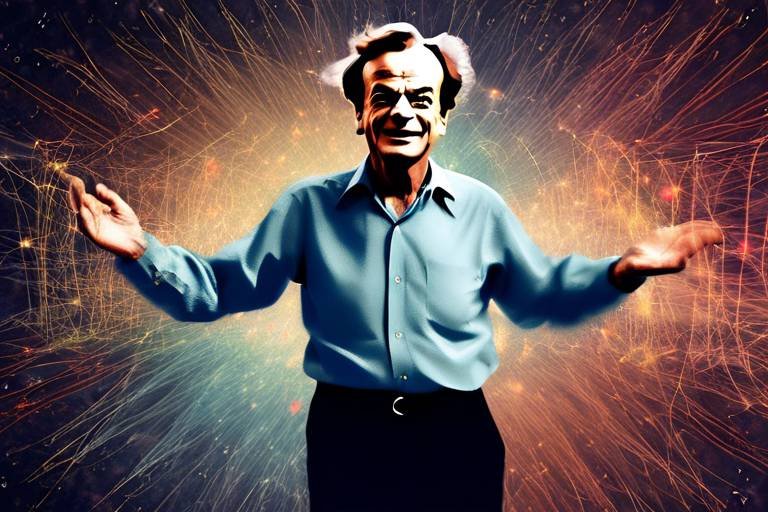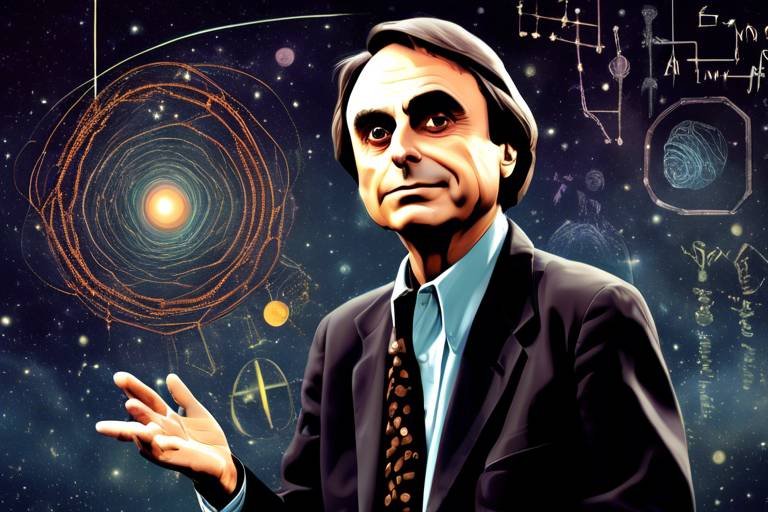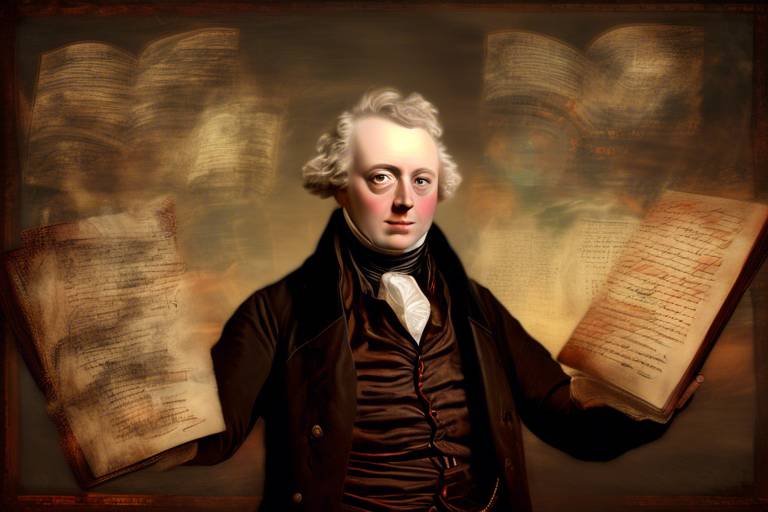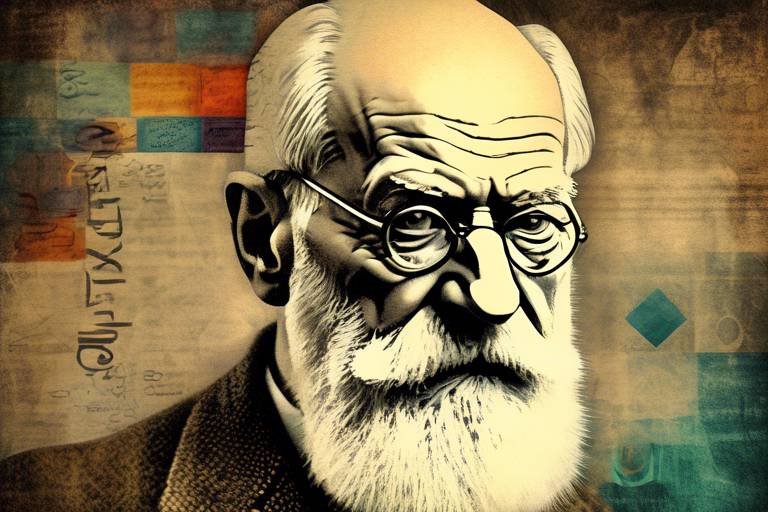The Work of Richard Feynman and Quantum Electrodynamics
Richard Feynman was not just a physicist; he was a force of nature. His contributions to quantum electrodynamics (QED) transformed our understanding of the universe at its most fundamental level. Imagine a world where the tiniest particles interact in ways that seem almost magical. This is the world Feynman helped to illuminate through his innovative theories and methods. In this article, we will explore the remarkable journey of Feynman, from his early life and education to his groundbreaking contributions to QED, and how his teaching philosophy has influenced generations of scientists.
Feynman's work in QED is particularly significant because it addresses the interactions between light and matter. Before his contributions, physicists struggled to reconcile the principles of quantum mechanics with classical electromagnetism. Feynman introduced a revolutionary approach that not only provided clarity but also paved the way for future discoveries in particle physics. His ability to simplify complex ideas into digestible formats, such as the famous Feynman diagrams, has made him a pivotal figure in modern physics.
As we dive deeper into Feynman's life and work, it becomes clear that his legacy goes beyond equations and theories. He was a passionate communicator of science, always eager to share his knowledge and inspire curiosity in others. Whether through his engaging lectures or popular books, Feynman's charm and enthusiasm for physics made complex concepts accessible to everyone. His impact is felt not only in the realm of theoretical physics but also in science communication as a whole, making him a true icon of the scientific community.
In the sections that follow, we will explore Feynman's early life and education, his major contributions to QED, and the philosophies that guided his teaching methods. We will also discuss the lasting impact of his work on modern physics and how it continues to inspire future generations. Get ready to embark on a journey through the mind of one of the greatest physicists of our time!

Feynman's Early Life and Education
Richard Feynman was born on May 11, 1918, in Queens, New York, to a Jewish family that valued education and curiosity. His father, Melville Feynman, was a schoolteacher who instilled in him a love for science and the importance of questioning the world around him. Feynman's early exposure to science was not just academic; it was deeply personal. He often spent hours tinkering with radios and conducting experiments, showcasing a natural inclination towards the mysteries of the universe.
As a child, Feynman was known for his inquisitive nature. He would often ask profound questions that left adults scratching their heads. This characteristic became a hallmark of his personality and later influenced his scientific work. He attended Far Rockaway High School, where he excelled in mathematics and science, but it was his unique approach to learning that set him apart. Instead of merely memorizing facts, he sought to understand the underlying principles, a trait that would define his later contributions to physics.
After high school, Feynman enrolled at the Massachusetts Institute of Technology (MIT) in 1935. Here, he immersed himself in the world of physics, studying under some of the greatest minds of the time. His undergraduate years were marked by a blend of rigorous academic work and a playful exploration of scientific concepts. Feynman was particularly drawn to the field of quantum mechanics, a domain that would later become his playground.
Feynman's education continued as he pursued his Ph.D. at Princeton University, where he worked under the guidance of the renowned physicist John Archibald Wheeler. His doctoral thesis, which focused on the principles of quantum electrodynamics, laid the groundwork for his future breakthroughs. It was during this period that Feynman developed his famous path integral formulation, a revolutionary approach that would change the landscape of quantum physics.
Throughout his educational journey, Feynman faced various challenges, including the pressures of academia and the complexities of advanced physics. However, he thrived in environments that encouraged creativity and critical thinking. This blend of rigorous training and a playful spirit not only shaped his scientific identity but also influenced his teaching philosophy. Feynman believed that education should be an exciting adventure, a belief he carried into his later years as a professor and lecturer.
In summary, Feynman's early life and education were characterized by a strong foundation in science, a relentless curiosity, and a unique approach to learning. These elements combined to create a brilliant mind that would go on to revolutionize the field of quantum electrodynamics and inspire generations of scientists. His journey reminds us that education is not just about acquiring knowledge; it's about fostering a passion for discovery and understanding the world around us.

Contributions to Quantum Electrodynamics
Richard Feynman's contributions to quantum electrodynamics (QED) are nothing short of revolutionary. His work fundamentally changed the way scientists understand electromagnetic interactions, making complex phenomena more accessible and comprehensible. Before Feynman, the field of QED was fraught with mathematical complexities that often left even the most seasoned physicists scratching their heads. However, Feynman introduced a fresh perspective that not only simplified these calculations but also provided a visual framework for understanding particle interactions.
One of Feynman's most significant contributions was the creation of Feynman diagrams. These diagrams serve as a graphical representation of the interactions between particles, allowing physicists to visualize and compute the probabilities of various processes in a straightforward manner. Imagine trying to solve a complicated puzzle without a picture; that's what physicists faced before Feynman's diagrams. With this innovative tool, they could see the pieces of the puzzle and how they fit together, making the abstract ideas of QED much more tangible.
Moreover, Feynman's work was not limited to theoretical aspects. He was deeply involved in practical applications of QED, which further cemented his legacy in the scientific community. His theories laid the groundwork for advancements in various fields, including particle physics, quantum computing, and even the development of new materials. For instance, the principles derived from QED have implications in understanding how light interacts with matter, which is crucial for advancements in photonics and telecommunications.
To illustrate the breadth of Feynman's contributions, consider the following table that summarizes some key aspects of his work in QED:
| Contribution | Description |
|---|---|
| Feynman Diagrams | Graphical representations of particle interactions that simplify complex calculations. |
| Path Integral Formulation | A method that describes quantum mechanics by summing over all possible histories of a system. |
| Renormalization | A technique to remove infinities from calculations in QED, making predictions finite and accurate. |
Feynman's innovative ideas didn't just stop at the theoretical level; they also reshaped how physicists approach problems in quantum mechanics. He emphasized the importance of intuitive understanding over rote memorization of equations. This philosophy encouraged scientists to think critically about the implications of their work, fostering a culture of inquiry and exploration that continues to thrive today.
In summary, Richard Feynman's contributions to quantum electrodynamics were transformative. He not only simplified the complex world of particle physics but also inspired countless others to delve deeper into the mysteries of the universe. His legacy is evident in the ongoing research and advancements in modern physics, proving that the power of clear thinking and innovative visualization can unlock new realms of understanding.

Feynman Diagrams Explained
Feynman diagrams are a revolutionary tool in the realm of quantum electrodynamics (QED), serving as a visual language that simplifies the complex interactions between particles. Imagine trying to navigate through a dense forest without a map; that’s how physicists felt before Feynman’s diagrams came into play. These diagrams provide a clear, pictorial way to represent interactions, making the intricate dance of particles much more comprehensible.
At their core, Feynman diagrams depict the paths of particles as they interact with one another. Each line in the diagram represents a particle, and the points where lines meet indicate interactions or exchanges of energy. This visual representation allows physicists to quickly grasp the relationships between particles and the forces acting upon them. For instance, when two electrons collide, the diagram illustrates not just their paths but also the exchange of virtual photons, which mediate the electromagnetic force between them.
One of the most significant advantages of Feynman diagrams is their ability to simplify calculations involving particle interactions. In traditional quantum mechanics, calculating probabilities for particle interactions can be a daunting task, often requiring complex mathematical equations. However, Feynman introduced a systematic way to translate these equations into diagrams, making it easier to perform calculations. By counting the number of ways particles can interact, physicists can compute probabilities without getting lost in a sea of equations.
To illustrate this further, consider the following table that outlines the basic components of a Feynman diagram:
| Component | Description |
|---|---|
| Lines | Represent particles; solid lines for fermions (e.g., electrons) and wavy lines for bosons (e.g., photons). |
| Vertices | Points where lines meet, indicating interactions or exchanges of particles. |
| External Lines | Indicate incoming and outgoing particles, representing initial and final states of the interaction. |
This table highlights the essential elements that compose a Feynman diagram, showcasing how these components come together to create a comprehensive picture of particle interactions. But, while Feynman diagrams are incredibly useful, it’s important to remember that they are not without their limitations. In certain scenarios, especially when dealing with high-energy physics or complex interactions, these diagrams may not capture the full picture. Nevertheless, they remain an invaluable asset in the physicist's toolkit, bridging the gap between abstract theory and tangible understanding.
In conclusion, Feynman diagrams not only revolutionized the way we visualize particle interactions but also transformed the approach to calculations in quantum electrodynamics. They serve as a testament to Feynman’s genius, encapsulating complex ideas in a format that is both accessible and enlightening. As we continue to explore the depths of quantum mechanics, these diagrams will undoubtedly remain a cornerstone of modern physics, guiding both seasoned researchers and budding scientists alike.

Applications of Feynman Diagrams
Feynman diagrams are not just theoretical constructs; they are powerful tools that have found extensive applications across various fields of physics. These diagrams serve as a bridge that connects abstract quantum theories with tangible experimental results, making them invaluable in both theoretical and experimental physics. For instance, in the realm of particle physics, Feynman diagrams are indispensable for predicting the outcomes of particle collisions and interactions. They enable physicists to visualize complex processes in a straightforward manner, which is crucial when analyzing data from particle accelerators like the Large Hadron Collider.
One of the most significant applications of Feynman diagrams is in the calculation of scattering amplitudes. By representing the interactions between particles, these diagrams allow physicists to compute probabilities of various outcomes with remarkable accuracy. In essence, they transform the daunting task of calculating particle interactions into a more manageable graphical format. This has led to groundbreaking discoveries, including the prediction of the existence of particles before they were experimentally confirmed.
Moreover, Feynman diagrams extend beyond particle physics. They are also used in fields such as quantum field theory, solid-state physics, and even quantum chemistry. For example, in quantum chemistry, these diagrams help in understanding electron interactions in atoms and molecules. They provide a visual representation of how electrons exchange energy and momentum, facilitating a deeper understanding of chemical reactions. The versatility of Feynman diagrams is one of the reasons they have become a staple in modern physics.
To illustrate the diverse applications of Feynman diagrams, consider the following table that summarizes their use in different areas of research:
| Field | Application |
|---|---|
| Particle Physics | Predicting outcomes of particle interactions |
| Quantum Field Theory | Calculating scattering amplitudes |
| Solid-State Physics | Understanding electron behavior in materials |
| Quantum Chemistry | Visualizing electron interactions in chemical reactions |
In conclusion, the applications of Feynman diagrams are vast and varied, making them a cornerstone of modern physics. Their ability to simplify complex interactions and enhance our understanding of fundamental processes is unparalleled. As research continues to evolve, the role of Feynman diagrams is likely to expand even further, paving the way for new discoveries and insights into the quantum world.

Limitations of Feynman Diagrams
While Feynman diagrams have become a cornerstone of modern physics, providing an intuitive way to visualize particle interactions, they are not without their limitations. One of the primary challenges is that these diagrams can sometimes oversimplify complex processes. For instance, while they effectively illustrate interactions at the quantum level, they may fail to capture the full range of phenomena occurring in certain high-energy environments. This can lead to misunderstandings or incomplete analyses of particle behavior.
Another significant limitation arises in the context of non-perturbative effects. Feynman diagrams are primarily useful in perturbation theory, which assumes that interactions can be treated as small corrections to a known solution. However, in situations where interactions are strong or where particles are bound together (like in the case of hadrons), perturbation theory breaks down, and hence, Feynman diagrams become less effective. In these scenarios, physicists often need to rely on alternative methods, such as lattice quantum field theory, which can provide a more accurate depiction of particle dynamics.
Moreover, Feynman diagrams can be somewhat misleading when it comes to time ordering of events. While they provide a clear visual representation of interactions, they do not inherently convey the temporal sequence of events in a straightforward manner. This can lead to confusion, especially for those new to quantum mechanics, as the diagrams might suggest a linear progression that doesn't accurately reflect the underlying quantum realities.
Additionally, Feynman diagrams are limited in their ability to represent multi-particle interactions comprehensively. As the number of particles involved increases, the complexity of the diagrams grows exponentially, making them unwieldy and difficult to interpret. This complexity can hinder their practical application in certain research scenarios, where simpler models might provide clearer insights.
In summary, while Feynman diagrams are a powerful tool in the physicist's toolkit, it is crucial to recognize their limitations. Understanding these constraints allows researchers to approach quantum electrodynamics with a more nuanced perspective, ensuring that they complement Feynman diagrams with other theoretical frameworks when necessary. As with any scientific tool, a balanced approach is essential for achieving a comprehensive understanding of the underlying phenomena.
- What are Feynman diagrams used for?
Feynman diagrams are used to visualize and calculate interactions between particles in quantum electrodynamics and other areas of quantum field theory. - Why are Feynman diagrams important?
They simplify complex calculations and provide an intuitive way to understand particle interactions, making them essential for both theoretical and experimental physicists. - What are the limitations of using Feynman diagrams?
They can oversimplify complex processes, struggle with non-perturbative effects, misrepresent time ordering, and become unwieldy with multi-particle interactions. - Are there alternatives to Feynman diagrams?
Yes, methods like lattice quantum field theory and other computational techniques are often used in scenarios where Feynman diagrams are less effective.

Feynman's Teaching Philosophy
Richard Feynman was not just a brilliant physicist; he was also an extraordinary teacher who had a knack for making complex concepts accessible and engaging. His teaching philosophy revolved around the idea that understanding is paramount. Feynman believed that if you couldn't explain a concept simply, you didn't truly understand it. This principle is often referred to as the "Feynman Technique," a method that encourages breaking down complex subjects into simpler parts, making them easier to grasp.
Feynman's classes were known for their lively atmosphere, where curiosity reigned supreme. He often employed a hands-on approach, inviting students to explore and experiment rather than passively absorb information. This interactive style fostered a sense of wonder and excitement about physics. Imagine walking into a classroom where the air buzzes with questions, where students are encouraged to challenge assumptions and think critically. That was Feynman's classroom.
One of the key tenets of Feynman's philosophy was the importance of **active engagement**. He often asked his students to teach back what they had learned, reinforcing their understanding and building confidence. This method not only solidified their knowledge but also cultivated a sense of ownership over their learning. Feynman believed that teaching was one of the best ways to learn, a notion that resonates with many educators today.
Moreover, Feynman was a firm advocate for making physics relatable. He often used analogies and real-world examples to illustrate abstract concepts. For instance, he would compare the behavior of particles to everyday experiences, making the material more approachable. This approach not only demystified physics but also made it relevant to students' lives. Feynman’s famous saying, “The only way to understand is to do,” encapsulates his belief that practical application is essential to learning.
In addition to his engaging teaching style, Feynman was known for his **infectious enthusiasm** for science. He approached teaching with a sense of playfulness and curiosity that inspired students to share in his passion. Whether it was through his captivating lectures or his popular books, Feynman had a unique ability to ignite a spark of interest in the minds of his audience. His legacy as a teacher is not just in the content he delivered, but in the way he made students feel about learning.
Feynman’s influence extended beyond the classroom. He was a pioneer in science communication, believing that scientists have a responsibility to share their knowledge with the public. His lectures, such as the famous “Feynman Lectures on Physics,” continue to be a valuable resource for learners worldwide. By breaking down barriers between scientists and the general public, Feynman opened the door for a broader appreciation of science.
In summary, Richard Feynman's teaching philosophy was characterized by a commitment to clarity, engagement, and enthusiasm. His innovative methods and dedication to making physics accessible have left a lasting impact on education and inspired generations of students to pursue their interests in science. As we continue to explore the wonders of the universe, Feynman’s legacy serves as a reminder of the joy of learning and the importance of effective communication in the world of science.
- What is the Feynman Technique? The Feynman Technique is a method of learning that involves explaining concepts in simple terms to ensure understanding.
- How did Feynman make physics relatable? Feynman used analogies and real-world examples to connect abstract concepts to everyday experiences.
- What impact did Feynman have on science communication? Feynman was a pioneer in making complex scientific ideas accessible to the public, inspiring interest and appreciation for science.
- Why is engagement important in teaching? Active engagement encourages students to think critically and take ownership of their learning, leading to a deeper understanding of the material.

Impact on Modern Physics
Richard Feynman's contributions to quantum electrodynamics (QED) have not only transformed our understanding of the universe at a fundamental level but have also had a profound impact on modern physics as a whole. His innovative ideas and methodologies have paved the way for new research directions, influencing both theoretical and experimental physics. Imagine a world where the intricate dance of particles is not just a mystery but a well-choreographed performance, all thanks to Feynman's insights. His work has become a cornerstone of quantum mechanics, allowing physicists to explore realms that were previously thought to be beyond comprehension.
One of the most significant impacts of Feynman's work is the way it has reshaped our understanding of electromagnetic interactions. Before Feynman, physicists struggled with complex theories that often seemed disconnected from observable phenomena. With the introduction of Feynman diagrams, he provided a visual and intuitive framework that simplified these interactions. This revolutionary approach has become a standard tool in particle physics, enabling scientists to calculate probabilities of particle interactions with unprecedented accuracy.
Furthermore, Feynman's teaching philosophy has left an indelible mark on how physics is taught today. His emphasis on clarity and engagement has inspired educators to adopt more interactive and student-centered teaching methods. Feynman's famous quote, "If you can't explain it simply, you don't understand it well enough," encapsulates his belief that understanding should be accessible to everyone, not just a select few. This approach has encouraged a new generation of physicists to communicate their ideas more effectively, bridging the gap between complex scientific concepts and public understanding.
In addition to his theoretical contributions, Feynman's work has led to practical advancements in various fields. For instance, his insights into quantum mechanics have influenced technologies such as:
- Quantum Computing: The principles of QED are foundational to the development of quantum computers, which promise to revolutionize information processing.
- Lasers: Understanding the interactions of photons and electrons has been crucial in the development of laser technology, impacting everything from telecommunications to medicine.
- Semiconductors: Feynman's theories have informed the design and functionality of semiconductor devices, which are essential in modern electronics.
Moreover, Feynman's legacy extends beyond academia. His ability to communicate complex ideas in an engaging manner has inspired countless individuals to pursue careers in science. Through his books, lectures, and even his participation in popular media, Feynman has made science more approachable and exciting for the general public. This has fostered a greater appreciation for scientific inquiry and its relevance to everyday life.
In conclusion, the impact of Richard Feynman's work on modern physics cannot be overstated. His contributions have not only advanced our understanding of the quantum world but have also transformed the way science is taught and communicated. As we continue to explore the mysteries of the universe, Feynman's legacy will undoubtedly guide future generations of physicists and inspire new discoveries that challenge our understanding of reality.
- What is quantum electrodynamics (QED)?
Quantum electrodynamics is the relativistic quantum field theory of electrodynamics, describing how light and matter interact. It is a crucial part of the Standard Model of particle physics.
- How did Feynman contribute to QED?
Feynman developed the concept of Feynman diagrams, which are graphical representations that simplify the calculations involved in particle interactions, making complex theories more accessible.
- Why are Feynman diagrams important?
They provide a visual framework that helps physicists understand and calculate the probabilities of particle interactions, making them essential tools in theoretical physics.
- What is Feynman's teaching philosophy?
Feynman believed in making science accessible and engaging. He emphasized the importance of clear communication and encouraged educators to adopt interactive teaching methods.

Legacy in Science Communication
Richard Feynman was not just a brilliant physicist; he was also a master communicator who had an extraordinary ability to make complex scientific concepts accessible to the general public. His unique approach to science communication has left a lasting legacy that continues to inspire both scientists and educators today. Feynman's knack for storytelling, combined with his infectious enthusiasm for physics, transformed the way science is perceived and taught.
One of the most remarkable aspects of Feynman's communication style was his use of analogies and metaphors. He had a talent for relating intricate scientific ideas to everyday experiences, making them relatable and easier to grasp. For instance, he often compared the behavior of particles to a game of chance, illustrating the probabilistic nature of quantum mechanics in a way that resonated with his audience. This ability not only engaged listeners but also sparked their curiosity, encouraging them to delve deeper into the subject matter.
Feynman’s lectures, particularly his famous series at the California Institute of Technology, were groundbreaking in their approach. He emphasized clarity and engagement, often inviting students to question everything, including his own assertions. This interactive style fostered a learning environment where students felt empowered to explore and challenge ideas, a significant shift from traditional rote learning methods. His book, “Surely You’re Joking, Mr. Feynman!”, is a testament to his storytelling prowess, blending humor and science in a way that captivates readers from all walks of life.
Moreover, Feynman was a pioneer in utilizing media to reach a broader audience. His participation in television programs and documentaries brought physics into homes around the world. He had an uncanny ability to break down complex theories into digestible segments, making them not only understandable but also enjoyable. This approach has influenced countless science communicators who followed in his footsteps, emphasizing the importance of making science accessible and engaging.
To illustrate Feynman’s impact on science communication, let’s look at some of the key elements that define his legacy:
- Storytelling: Feynman used narratives to explain scientific concepts, making them relatable and engaging.
- Interactive Learning: He encouraged questioning and exploration, fostering a more dynamic learning environment.
- Media Engagement: His use of television and public lectures helped popularize physics, reaching audiences far beyond the academic community.
Feynman’s legacy in science communication is not just about his individual contributions; it’s about the movement he inspired. He showed that science is not merely a collection of facts and figures but a vibrant and exciting field that can be explored and enjoyed by everyone. His influence can be seen in the work of modern science communicators who strive to make complex ideas accessible, ensuring that the wonders of science continue to inspire future generations.
In conclusion, Richard Feynman's legacy in science communication is a reminder of the power of effective communication in bridging the gap between science and society. His ability to make physics exciting and relatable has paved the way for a new generation of scientists and educators, ensuring that the beauty of the universe remains within reach for all who seek to understand it.
- What was Richard Feynman's most significant contribution to physics?
Feynman's most significant contribution was his work on quantum electrodynamics (QED), where he developed Feynman diagrams that revolutionized our understanding of particle interactions. - How did Feynman influence science education?
Feynman influenced science education by promoting interactive learning and encouraging students to question and engage with complex scientific concepts. - What is the importance of Feynman diagrams?
Feynman diagrams serve as a visual tool to simplify and calculate particle interactions in quantum mechanics, making it easier for physicists to understand and predict outcomes. - How did Feynman make science accessible to the public?
Feynman made science accessible through storytelling, engaging lectures, and media appearances that broke down complex ideas into relatable concepts.

Influence on Future Generations
Richard Feynman’s legacy is not just confined to the pages of physics textbooks; it pulsates through the veins of modern science, inspiring countless physicists and researchers around the globe. His innovative approaches and inquisitive spirit have left an indelible mark on the scientific community, encouraging future generations to embrace curiosity and creativity in their own explorations of the universe. Imagine a world where the boundaries of knowledge are constantly pushed back, where the impossible becomes possible—this is the world that Feynman envisioned and worked towards.
One of the most profound influences Feynman had was in the realm of problem-solving. He famously stated, “The first principle is that you must not fool yourself—and you are the easiest person to fool.” This mantra resonates deeply among young scientists, reminding them that skepticism and rigorous questioning are essential tools in their quest for understanding. Feynman’s ability to tackle complex problems with a sense of playfulness and simplicity encourages students to approach challenges with an open mind, making science feel less like a daunting task and more like an exciting adventure.
Moreover, his unique teaching style has become a template for educators in various fields. Feynman believed in the importance of engagement and clarity, often using analogies and real-world examples to illustrate complex concepts. This approach has inspired educators to adopt similar methods, fostering a generation of learners who are not only knowledgeable but also passionate about science. Feynman’s famous lectures, particularly those captured in “The Feynman Lectures on Physics,” continue to be a source of inspiration for teachers and students alike, demonstrating that learning can be both informative and enjoyable.
Feynman’s influence extends beyond physics; it permeates the realms of science communication and public understanding of science. By engaging with the public through lectures, books, and television appearances, he made science accessible to everyone. His ability to distill complex scientific ideas into digestible narratives has inspired a new wave of scientists to communicate their work effectively, ensuring that knowledge is not confined to academic circles but shared with the broader community. This legacy of communication is vital in a world where scientific literacy is increasingly important.
Furthermore, Feynman’s work has sparked interest in interdisciplinary research. His contributions to quantum electrodynamics have not only advanced physics but have also influenced fields such as chemistry, materials science, and even computer science. The principles he established encourage collaboration across disciplines, fostering an environment where innovative ideas can flourish. Future scientists are inspired to break down the silos of traditional academic fields, leading to groundbreaking discoveries that might not have been possible otherwise.
In summary, Richard Feynman's influence on future generations is profound and multifaceted. His legacy lives on through the countless students he inspired, the educators who emulate his teaching style, and the scientists who continue to push the boundaries of knowledge. As we navigate the complexities of the modern world, Feynman’s spirit of inquiry and enthusiasm for discovery remains a guiding light, reminding us all of the joy and wonder that comes with exploring the unknown.
- What are Feynman diagrams?
Feynman diagrams are graphical representations used in quantum electrodynamics to visualize the interactions between particles. They simplify complex calculations and help physicists understand quantum processes more intuitively.
- How did Feynman influence science communication?
Feynman was a pioneer in making complex scientific concepts accessible to the general public. His engaging lectures and writings inspired many scientists to communicate their work effectively, bridging the gap between academia and the public.
- What is Feynman's teaching philosophy?
Feynman's teaching philosophy emphasized clarity, engagement, and the importance of understanding concepts deeply rather than rote memorization. He often used analogies and real-life examples to make science relatable and exciting.
Frequently Asked Questions
- Who was Richard Feynman?
Richard Feynman was a brilliant American physicist known for his work in quantum electrodynamics (QED). He was not only a Nobel laureate but also a charismatic teacher and a popular science communicator. His unique approach to teaching and his ability to simplify complex concepts made him a beloved figure in the world of science.
- What is quantum electrodynamics (QED)?
Quantum electrodynamics is the quantum field theory that describes how light and matter interact. It combines classical electromagnetism with quantum mechanics, allowing physicists to understand phenomena such as the behavior of photons and electrons. Feynman's contributions to QED helped lay the groundwork for modern particle physics.
- What are Feynman diagrams?
Feynman diagrams are graphical representations that depict the interactions of particles in quantum field theory. They simplify complex calculations by providing a visual way to understand particle exchanges and interactions. Each line and vertex in a Feynman diagram corresponds to specific particles and their interactions, making it easier for physicists to visualize and compute outcomes.
- How did Feynman contribute to the development of Feynman diagrams?
Feynman introduced these diagrams as a way to simplify the calculations involved in quantum electrodynamics. By using a visual format, he made it easier for physicists to calculate probabilities of various particle interactions, revolutionizing the way complex quantum processes were understood and handled.
- What are the applications of Feynman diagrams?
Feynman diagrams have practical applications in various fields of physics, including particle physics, condensed matter physics, and even in the study of quantum computing. They help physicists visualize and calculate the outcomes of particle collisions and interactions, which are fundamental to understanding the universe at a subatomic level.
- Are there limitations to Feynman diagrams?
Yes, while Feynman diagrams are powerful tools, they have limitations. They may not adequately represent certain complex interactions, especially in non-perturbative regimes or in cases involving strong nuclear forces. In such scenarios, alternative approaches and theories may be required to provide a complete understanding.
- What was Feynman's teaching philosophy?
Feynman's teaching philosophy emphasized clarity, engagement, and the importance of understanding concepts rather than rote memorization. He believed in making learning enjoyable and accessible, often using analogies and real-world examples to explain complex scientific ideas. His approach has influenced countless educators and students alike.
- How has Feynman influenced modern physics?
Feynman's contributions to quantum electrodynamics and his innovative teaching methods have had a lasting impact on modern physics. His work continues to inspire researchers and educators, shaping the way physics is taught and understood today. Many contemporary physicists cite Feynman as a significant influence on their own work and thinking.
- What is Feynman's legacy in science communication?
Feynman's legacy in science communication is profound. He was a master at making complex scientific concepts accessible to the general public through his lectures, books, and television appearances. His ability to communicate effectively has inspired a generation of scientists and educators to prioritize clarity and engagement in their own work.
- How does Feynman's work continue to inspire future generations?
Feynman's innovative ideas and teaching methods continue to inspire future generations of physicists and researchers. His emphasis on curiosity, exploration, and the joy of discovery encourages new scientists to think creatively and tackle complex problems, ensuring that his influence will be felt for years to come.

